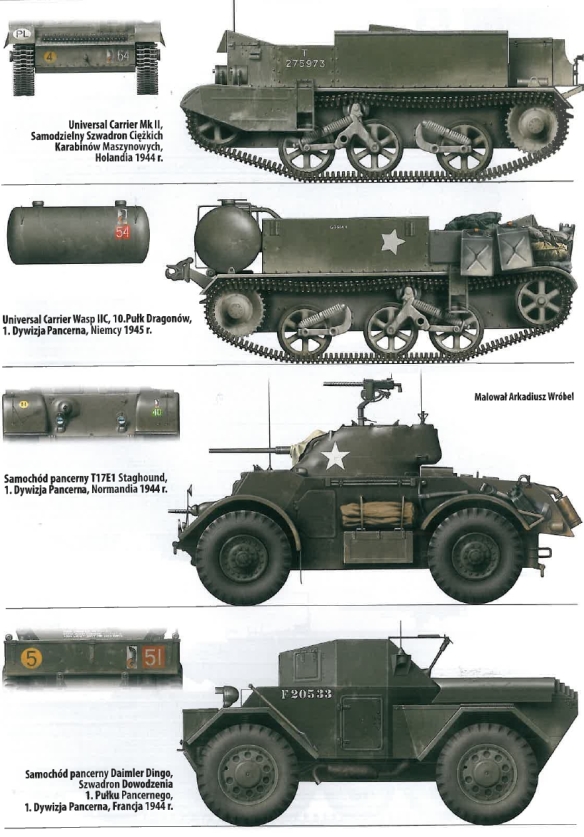Some 100,000 Polish soldiers managed to evade capture and escaped through Romania, Hungary, and the Baltic states. Many eventually made their way to France and joined the Polish government-in-exile, which was headed by General Władysław Sikorski. Meanwhile, as early as May 1939, Polish and French officials had discussed the feasibility of forming military units manned by some of the half million Polish immigrants then living in France. By May 1940, the reconstituted Polish army in France had some 84,500 troops organized into two infantry divisions and a mechanized brigade. In addition, the Podhale Rifle Brigade fought in Norway and at Narvik, and the independent Carpathian Rifle Brigade was formed in the Middle East.
During the 1940 France Campaign, the Polish 1st Grenadier Division was destroyed fighting in Lorraine. The 2nd Rifle Division escaped into Switzerland, and its soldiers were interned there for the remainder of the war. Only some 30 percent of the Polish army managed to escape to Britain, where it again reconstituted and formed the Polish I Corps. That unit eventually consisted of the 1st Armored Division, the 4th Infantry Division, and the 1st Independent Parachute Brigade. The parachute brigade’s most celebrated battle was its doomed jump into Arnhem to support the British there in Operation MARKET-GARDEN in September 1944.
1st Armored Division
The Polish 1st Armoured Division (Polish 1 Dywizja Pancerna) was an Allied military unit during World War II, created in February 1942 at Duns in Scotland. At its peak it numbered approximately 16,000 soldiers. It was commanded by General Stanisław Maczek.
The division was formed as part of the I Polish Corps In the early stages the division was stationed in Scotland and guarded approximately 200 kilometres of British coast.
Normandy. By the end of July 1944 the division had been transferred to Normandy. The final elements arrived on August 1 and the unit was attached to the First Canadian Army. It entered combat on August 8 during Operation Totalize. The division twice suffered serious bombings by Allied aircraft which accidentally bombed friendly troops, but yet it achieved a victory against the Wehrmacht in the battles for Mont Ormel, and the town of Chambois. This series of offensive and defensive operations came to be known as the Battle of Falaise in which a large number of German Wehrmacht and SS divisions were trapped in the Falaise pocket and subsequently destroyed. Maczek’s division had the crucial role of closing the pocket at the escape route of those German divisions, hence the fighting was absolutely desperate and the 2nd Polish Armoured Regiment, 24th Polish Lancers and 10th Dragoons supported by the 8th and 9th Infantry Battalions took the brunt of German attacks trying to break free from the pocket. Surrounded and running out of ammunition they withstood incessant attacks from multiple fleeing panzer divisions for 48 hours until they were relieved.
Belgium and the Netherlands
After the Allied armies broke out from Normandy, the Polish 1st Armoured Division pursued the Germans along the coast of the English Channel. It liberated, among others, the towns of Saint-Omer, Ypres, Ghent and Passchendaele. A successful outflanking manoeuvre planned and performed by General Maczek allowed the liberation of the city of Breda without any civilian casualties (October 29, 1944). The Division spent the winter of 1944-1945 on the south bank of the river Rhine, guarding a sector around Moerdijk, Netherlands. In early 1945 it was transferred to the province of Overijssel and started to push along with the Allies along the Dutch-German border, liberating the eastern parts of the provinces of Drenthe and Groningen with towns such as Emmen, Coevorden and Stadskanaal.
Germany
In April 1945 the 1st Armoured entered Germany in the area of Emsland. On May 6 the division seized the Kriegsmarine naval base in Wilhelmshaven, where General Maczek accepted the capitulation of the fortress, naval base, East Frisian Fleet and more than 10 infantry divisions. There the Division ended the war and was joined by the Polish 1st Independent Parachute Brigade. It undertook occupation duties until 1947, when the division was disbanded, it and the many Polish displaced persons in the Western occupied territories forming a Polish enclave at Haren in Germany which was for a while known as “Maczków”. The majority of its soldiers opted not to return to now Soviet occupied Poland and stayed in exile.
Organization during 1944-45
10th Armoured Cavalry Brigade (10 Brygada Kawalerii Pancernej) – Col. T. Majewski
1st Polish Armoured Regiment (1 pułk pancerny) – Lt.Col. Aleksander Stefanowicz
2nd Polish Armoured Regiment (2 pułk pancerny) – Lt.Col. S. Koszustki
24th Polish Lancers Regiment (Armoured; 24 pułk ułanów im. Hetmana Żółkiewskiego) – Lt.Col. J. Kański
10th Polish Dragoons Regiment (10 pułk dragonów zmotoryzowanych) – Lt.Col. Władysław Zgorzelski
3rd Polish Infantry Brigade (3 Brygada Strzelców) – Col. Marian Wieroński
1st Polish Highland Battalion (1 battalion Strzelców Podhalańskich) – Lt.Col. K. Complak
8th Polish Rifle Battalion (8 battalion strzelców) – Lt.Col. Aleksander Nowaczyński
9th Polish Rifle Battalion (9 battalion strzelców flandryjskich) – Lt.Col. Zygmunt Szydłowski
1st Polish Independent HMG Squadron (samodzielna kompania ckm.) – Maj. M. Kochanowski
Divisional Artillery (Artyleria dywizyjna) – Col. B. Noel
1st Polish Motorized Artillery Regiment (1 pułk artylerii motorowej) – Lt.Col. J. Krautwald
2nd Polish Motorized Artillery Regiment (2 pułk artylerii motorowej) – Lt.Col. K. Meresch
1st Polish Anti-Tank Regiment (formed in 1945 from smaller units) (1 pułk artylerii przeciwpancernej) – Major R. Dowbór
1st Polish Light Anti-Aircraft Regiment (1 pułk artylerii przeciwlotniczej) – Lt.Col. O. Eminowicz, later Maj. W. Berendt
Other Units
10th Polish Mounted Rifle Regiment (10 pułk strzelców konnych) (amoured reconnaissance equipped with Cromwell tanks) – Maj. J. Maciejowski
HQ, Military Police,
engineers (saperzy dywizyjni) – Lt.Col. J. Dorantt
signals (1 batalion łączności) – Lt.Col. J. Grajkowski
administration, military court, chaplaincy, reserve squadrons, medical services.
Numbers
885 – officers and NCOs
15,210 – soldiers
381 – tanks (mostly M4 Shermans)
473 – artillery pieces (mostly motorized)
4,050 – motor cars, trucks, utility vehicles, artillery carriers.
LINK
